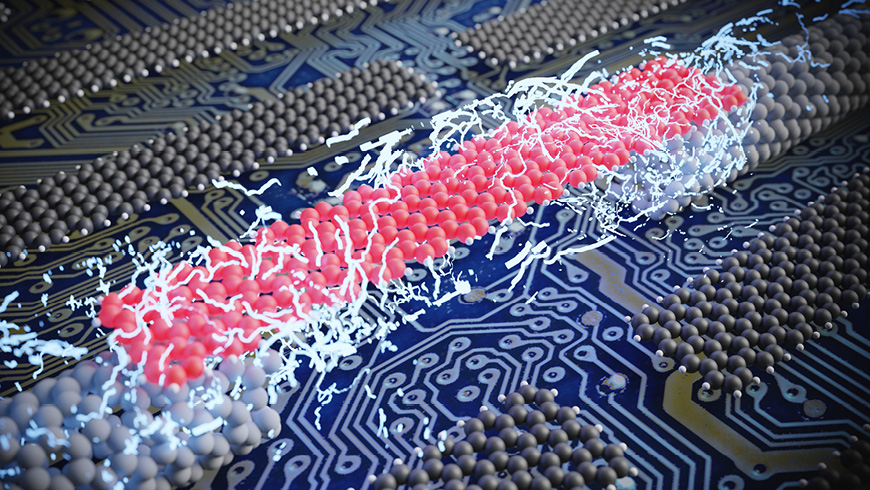Quantum technology from carbon

Nanoribbons of graphene have extraordinary properties that can be precisely controlled. Researchers at Empa, Peking University and the University of Warwick have succeeded for the first time in attaching electrodes to individual nanoribbons with atomic precision. They are thus paving the way for a precise characterisation of the "miracle ribbons" and their possible application in quantum technology.
It is promising, but also perplexing and confusing: quantum technology is expected to provide us with technological breakthroughs in the coming decades, such as smaller and more precise sensors, highly secure communication networks and powerful computers that can help develop new medicines and materials, control financial markets and predict the weather in the shortest possible time.
For this, we need so-called quantum materials: substances that exhibit pronounced quantum physical effects. One of these is graphene. This two-dimensional structural form of carbon has unusual physical properties, such as extraordinarily high tensile strength, thermal and electrical conductivity. If one restricts the already two-dimensional material even more spatially, for example to a narrow band, controllable quantum effects arise.
This is precisely what Mickael Perrin’s team is exploiting: In the Empa laboratory “Transport at Nanoscale Interfaces”, headed by Michel Calame, scientists in Perrin’s team are researching graphene nanoribbons. “Nanoribbons of graphene are even more fascinating than graphene itself,” explains Perrin. “By varying their length and width, as well as the shape of their edges, and by adding other atoms to them, you can give them all kinds of electrical, magnetic and optical properties.”
Real precision work – down to the atom
Research on the promising ribbons is not always easy. The narrower the band, the clearer its quantum properties – but the more difficult it is to control a single band. But this is precisely what is needed to understand the special features and possible applications of this quantum material in detail.
In a new study recently published in the journal Nature Electronics, Perrin, Jian Zhang and their team have succeeded for the first time in making electrically conductive contact with individual long, atomically precise graphene nanoribbons. No trivial task: “A graphene nanoribbon that is only nine carbon atoms wide measures just one nanometre in width,” says Zhang. To contact individual ribbons, the researchers used equally small electrodes: carbon nanotubes with a diameter of just one nanometre as well.
The precision that is indispensable for such an experiment already begins with the starting materials. The researchers obtained the graphene nanoribbons from Empa’s “nanotech@surfaces” laboratory under the direction of Roman Fasel, with whom they have been working for a long time. “Roman Fasel and his team have been working on graphene nanoribbons for a long time and can synthesise many different types of them with atomic precision from individual starting molecules,” explains Perrin. The starting molecules came from the Max Planck Institute for Polymer Research in Mainz.
If you want to advance the state of the art, interdisciplinarity is key. Thus, different international research groups were involved in the study, each with their own area of expertise: the carbon nanotubes were produced by a research group at the University of Beijing, and Empa scientists worked with researchers from the University of Warwick to interpret the results. “A project like this would not be possible without cooperation,” Zhang emphasises.
Contacting individual ribbons with the nanotubes was a challenge for the researchers. “The carbon nanotubes and the graphene nanoribbons are grown on separate substrates,” Zhang explains. “First, the tubes have to be transferred to the experimental substrate and contacted with metal electrodes. Then we cut them using high-resolution electron beam lithography to separate them into two electrodes each.” Finally, the tapes are transferred to the same substrate. Precision is essential here: Even the slightest rotation of the substrates can prevent successful contact. “Access to a high-quality infrastructure at the “Binnig and Roher Nanotechnology Center” at the IBM research centre in Rüschlikon was crucial for testing and implementing this technology,” says Perrin.
Dreams of the future
The scientists confirmed the success by measuring charge transport. “Quantum effects are usually more pronounced at low temperatures, which is why we carried out the measurements at temperatures close to absolute zero in a high vacuum,” explains Perrin, while also mentioning a particularly promising property of graphene nanoribbons: “Thanks to their extremely small size, their quantum properties are very robust. We expect them to still be detectable even at room temperature.” According to the researcher, this could allow us to develop quantum technologies that do not require an elaborate cooling infrastructure.